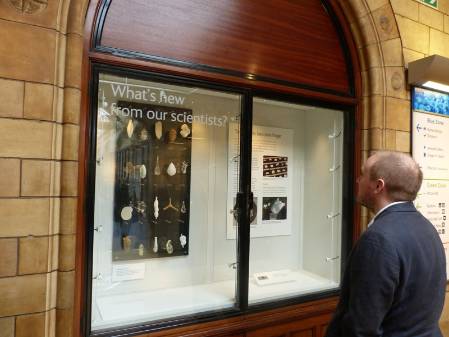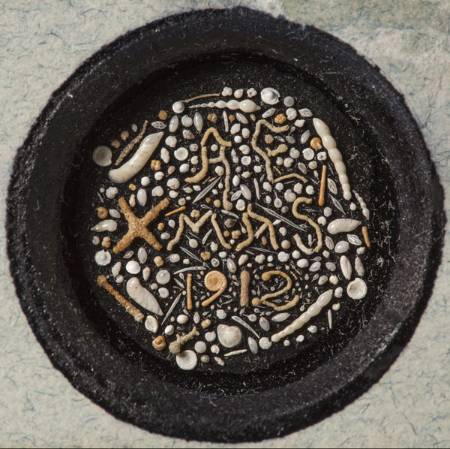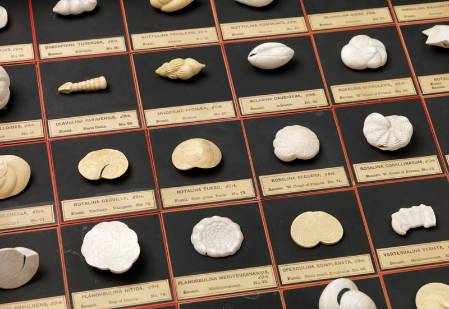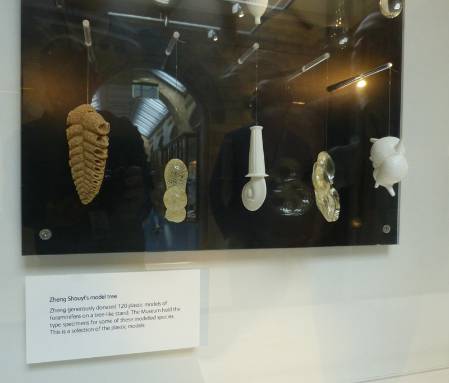Last month a new temporary display featuring some of our foraminiferal specimens and models was placed in the Museum gallery. This features real microfossils on one of our foraminiferal Christmas card slides alongside 20 scale models, part of a set of 120 models generously donated to us last year by Chinese scientist Zheng Shouyi.
Senior Microfossil Curator Steve Stukins admiring some of the specimens and models on display and thinking "this is a much better place for them than the Curator of Micropalaeontology's office!"
As a curator dealing with items generally a millimetre or less in size I have not often been involved in developing exhibits other than to provide images or scale models like the Blaschka glass models of radiolarians. Displaying magnified models is one of the best ways to show the relevance of some of the smallest specimens in the Museum collection, the beauty and composition of foraminifera and to highlight our unseen collections.
This display features one of our most treasured items, a slide with microscopic foraminifera arranged in patterns to spell out the words 'XMAS 1912'.
A festive slide of foraminifera created by Arthur Earland.
This was created by Arthur Earland for his long time collaborator Edward Heron-Allen. A previous blog tells of the sad end to the relationship between these two early 20th Century foraminiferal experts, a story that featured in the Independent under the heading 'shell loving scientists torn apart by mystery woman'.
The slide itself is amazingly beautiful under the microscope and a close up view (see above) is shown on the back board of the exhibit. The naked eye can show the arrangement of the specimens on the slide but cannot really pick out the beauty of the foraminifera. I was at a collections management conference about a year ago where it was suggested that the public feel duped by seeing models rather than real specimens on display. In this instance, the scale models serve to show the beauty as well as to enhance the relevance of the real specimens on display.
Foraminiferal models by Alcide d'Orbigny that also feature in the display.
French scientist d'Orbigny (1802-1857) was the first to recognise that creating models was a good way to show his studies on the foraminifera. These models were created to illustrate the first classification of the foraminifera, a group that at the time were classified as molluscs.
A selection of Zheng Shouyi's models of foraminifera.
Chinese scientist Zheng Shouyi was inspired by d'Orbigny to create models of foraminifera to illustrate her work and to show the beauty of the Foraminifera. Of the 120 models she donated to us in 2014, 20 have been carefully selected for this exhibit. The selection shows a variety of different wall structures, a range of shapes, species for which we have the type specimen as well as some species of planktonic foraminifera relevant to current research at the Museum. Zheng Shouyi is also famous for encouraging and overseeing the production of the world's first foraminiferal sculpture park in Zhongshan, China.
If you are able to pop into the Museum, please come and see this free display. It is situated just after the exit from the dinosaur exhibition on the opposite wall to the dino shop. We can't promise any giant scuptures but I'm sure that you'll agree that these models certainly illustrate the beauty and help to explain the relevance of some of the smallest specimens hidden behind the scenes at the Museum.






